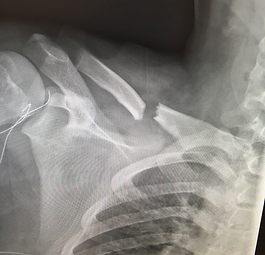Orthopaedic Surgeon

What is a clavicle?
The clavicle or collar bone is an important bone in the shoulder and chest. Most people can feel their clavicle next to their neck moving to the shoulder. The red arrow in this image, on the right, is pointing to the clavicle.
What causes a clavicle fracture?
The clavicle is susceptible to fracture when a person falls on their arm or shoulder. Many sports, especially contact sports, can result in a clavicle fracture. Bicyclists are especially prone to clavicle fractures if they fall from their bike.
Clavicle Fractures

How are clavicle fractures treated?
Many clavicle fractures can be treated without surgery. The patient is given a sling for comfort and in approximately 6-8 weeks the fractures will heal together with a small bony bump. If the fracture is significantly displaced or the individual continues to be very active, they may benefit from operative fixation with surgery. We typically fix the fractures with a plate and screws. We try to leave the plate and screws in forever but because the clavicle is so superficial some patients find the hardware is prominent and uncomfortable. This can be especially troublesome with purse and backpack use over the shoulder. The hardware can be removed but then time bust be given for the screw holes in the bone to heal so that another re-fracture does not occur.

Clavicle Fracture: note the break in the middle of the collar bone.
Images courtesy of Dr. Skelley.

Surgical fixation with plate and screws to bring the fracture into contact. These images are rotated to level the image from the fluoroscopic machine taking the images in the operating room.
References
1. van der Meijden OA, Gaskill TR, Millett PJ. Treatment of clavicle fractures: current concepts review. Journal of Shoulder and Elbow Surgery. 2012;21(3):423-429. doi:10.1016/j.jse.2011.08.053.
